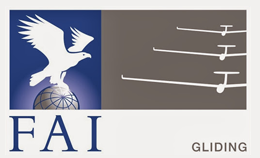
国際滑空記章へチャレンジするためにはルールを理解していることが必要になります。下記の Sporting Code Section 3が滑空スポーツの国際滑空記章に関するルールになります。Section 3 Annex C がSection 3 の解釈を解説した資料になります。これらの資料をよく読んでみましょう。

FAIの規程
FAI 定款 2024年版
(FAI Statutes の日本語訳)
FAI 定款付則 2024年版
(FAI By-Lawsの日本語訳)
FAI Sporting Code General Section 2024年版
(航空スポーツについての基本規程)
(同上の日本語訳)
FAI Sporting Code Section 3 Gliding
(滑空スポーツの滑空記章および記録飛行に関する諸規程)
Annex A – Rules for World and Continental Championships
(競技会に関する規程)
IGC Handicap List
(FAIクラブクラス競技会で用いられる各競技機のハンディキャップ表)
Annex B – Validation of Performances – Equipment & Procedures.pdf
(GNSSフライトレコーダー、高度記録機器、時刻記録機器について)
Annex C – Official Observer and Pilot Guide
(パイロットおよび公式立会人へのアドバイス)
Annex D – Rules for the Official Ranking List
(IGC ランキングについて)
規程は例年秋(10月頃)に改訂されます。
国際滑空記章銀章距離科目 よくある問合せ
質問1:国際滑空記章銀章の直線距離50kmの課目の最新の規程はどこから入手できますでしょうか。
近年、距離計測の国際基準が変更されていると聞いたので詳しく知りたいです。
回答1 最新版の規程はこちらをご参照ください⇒Sporting Code Section 3
(1)銀章 50km課目について
該当箇所は以下となります。
■Sporting Code Section 3 の page 9/21
2.2.1 Silver Badge The Silver badge is achieved on completing these soaring performances:
a. SILVER DISTANCE
A straight distance flight from a start at release to a finish fix located at least 50 km from release and at least 50 km from the fix recorded at the beginning of the take-off roll.
The Silver distance should be flown without guidance from another pilot. See SC3C-2.3.
離脱ポイントから少なくとも 50km 以上かつ、離陸から50km以上のfinish fix への直線距離飛行
銀章距離科目は他のパイロットからのガイダンスを得ずに飛行すること。
以下もご参照ください。
■Sporting Code Section 3 Annex C Official Observer & Pilot Guide page 7/40
2.3 The Silver distance flight
The Silver distance is a “leaving the nest” adventure, intended to get you away from your home airfield and to plan for a potential land-out. The “no-help-or-guidance” note in SC3-2.2.1a applies, meaning even help from other Silver distance hopefuls that day, or team flying. Any finish fix at least 50 km from your release point or MoP stop and your launch point is required, regardless of any other turn points that may be declared, or the success or not of a greater task. Any longer task is evaluated separately, on its own merits.
When Silver distance is the only objective, plan a finish fix a bit more than 50 km from the beginning of the take-off roll, so you have some flexibility in where to release. If a finish fix is planned 55 km from the begining of the take-off roll, then release can be anywhere within 5 km of the airfield.
For all Silver distance claims, the maximum LoH permitted for a flight over 100 km is calculated as in paragraph 3.2, and the maximum LoH permitted for a flight under 100 km is calculated as in 3.1. If the Loss of Height (LoH) between release and the selected finish fix is excessive, then choose another fix that is within the LoH limits. Common flight analysis software can be used to find the beginning of the take-off roll at launch. 2.14 gives instructions.
※離脱ポイントから50km以上、かつ、離陸ポイントから50km以上、のポイントを自由に飛行後に選択することが出来ます。
(2)適用される制限について
■Sporting Code Section 3 の page 7/21
LOSS OF HEIGHT
1.3.4 The START ALTITUDE minus the FINISH ALTITUDE. Given an excess LOSS OF HEIGHT, see 2.4.4 for badge claims and 3.1.5 for record claims.
(1.3.4 高度損失 【LoH】 スタート高度からフィニッシュ高度をひいたもの。バッジフライトでは2.4.4、記録飛行では3.1.5 に従って補正されます)
■Sporting Code Section 3 のpage 11/21
2.4.4 Loss of height limits
For distances greater than 100 kilometres where the LoH exceeds 1000m using barometric data or 900m using GPS height data, an adjustment of 100 times the excess LoH shall be subtracted from the length of the course. For distances of 100 kilometres or less, the flight is invalid if the LoH exceeds 1% of the distance using barometric data or [1% of course distance less 100m] using GPS height data.
(2.4.4 LoH(損失高度)の制限
距離が 100 キロメートル以下の場合、LoH が気圧データを使用して距離の 1% を超える場合、または GPS 高度データを使用して [コース距離の 1% から 100m を引いた値] を超える場合、飛行は無効になります。
【例】 52km のフライトの場合、 LoH が気圧高度で 520m 以下ということです
質問2:銀章 滞空時間 5時間以上 のデータファイル無しの申請について
FAI国際滑空記章交付規程の4.7.3の箇所に以下の記載があります。
4.7.3 当該飛行を証明するもの
自記高度計(バログラフ)記録証明書やGNSS Flight Recordersのigcデータファイル。
ただし、滞空時間については、公式立会人の監視のもとに実施する場合は不要とする
これは滞空時間の記録が離着陸場の付近で行われた場合はGPSデータが無くとも申請できるという認識でよろしいのでしょうか。
回答2:滑空機上級の場合、公式立会人の立ち会いがあれば、GPSデータが無くても申請はできます。滞空時間の公式立会人は日本滑空記章試験員も立ち会うことが出来ます。(もしデータをいただいた場合は、航空協会で保管させていただきます。)ご参考までに、ここでは規程上ですと以下の箇所が該当します。
■Sporting Code Section 3のpage 10/21
2.4 FLIGHT EVIDENCE REQUIREMENTS
2.4.1 Time evidence
The data sampling rate in each FR or PR used must be set to at least once per minute. If the glider has no MoP, the 5-hour duration task may be flown with no FR or PR if the OO controls the flight as given in 4.3.2.
4.4.2 Certificates
d. TAKE-OFF and LANDING TIME CERTIFICATE
This certificate states the time and location of takeoff, and for a duration flight having no FR/PR on board, also the landing time.
質問3:GNSSフライトレコーダーの較正について
銀章高度課目 獲得高度1,000mを実施したいです。フライトレコーダーの較正はいつ実施する必要がありますでしょうか?
回答:
フライトレコーダーを利用する銀章獲得高度の申請の場合、5年以内に較正を実施している場合、気圧高度で獲得高度を確認します。5年以内の較正がない場合、GPS高度で獲得高度を確認します。GPS高度の場合、100メートルのエラーマージンが必要になります。
2.4.3 Altitude evidence
GPS altitudes use the WGS84 Ellipsoid as the GPS altitude zero datum.
a. A copy of the calibration certificate of each FR used shall be submitted with the claim. The pressure altitude evidence is to be corrected using the calibration chart data when the precise altitude is critical to the claim (see 4.3.4c).
c. If PR barometric data is not available or the FR calibration period has lapsed, GPS height data may be used for Silver and Gold claims, provided that a 100 meter error margin is applied to all pressure height requirements of the Code (example: the gain of height is at least 1100 meters for Silver altitude). An example is given in SC3C-3.3.
2.4.3 高度の証拠
GPS 高度は、WGS84 楕円体を GPS 高度ゼロ基準として使用します。
a. 使用した各 FR の較正証明書のコピーを請求とともに提出するものとします。 正確な高度が申請にとって重要である場合、気圧高度の証拠は較正図データを使用して修正されます (4.3.4c を参照)。
c. ポジションレコーダーで気圧データが利用できない場合、または フライトレコーダーの較正期間が経過した場合、銀章・金章の申請にGPS高度を利用することが出来ます。GPS高度を利用sル場合、規程で定められた気圧高度要件に100メートルのエラーマージンが適用されます (例: 銀章高度の場合、獲得高度は少なくとも 1100 メートルになります)。 例は SC3C-3.3 に示されています。
2.4.6 Barometric calibration period
Calibration requirement of the barometric recording function varies with the claimed task as follows:
a. Silver or Gold claims using an FR or PR with no calibration data – 2.4.3c applies.
b. Silver, Gold, Diamond Goal & Diamond Distance claims using an FR having calibration data – no periodic calibration needed but the most recent calibration shall be used.
c. Diamond Altitude & Diploma claims – FR shall be calibrated within 5 years prior to the flight or within 2 months after the flight.
2.4.6 気圧較正期間
気圧記録機能の較正要件は、要求されたタスクによって次のように異なります。
a. 較正データのないフライトレコーダーまたはポジションレコーダーを使用した銀章または金章の申請 – 2.4.3c が適用されます。
b. 銀章、金章、ダイヤモンド・ゴール章およびダイヤモンド距離章は、較正データを持つフライトレコーダーを使用して表示されます。定期的な較正は必要ありませんが、最新の較正が使用されます。
c. ダイヤモンド高度章とFAI Diploma章に関する申請 – フライトレコーダーは飛行前 5 年以内、または飛行後 2 か月以内に校正されるものとします。
Official Observer Training(公式立会人トレーニングビデオ)
FAI国際滑空記章公式立会人向けのトレーニングビデオです。字幕を日本語にすることで、公式立会人の業務がわかりやすく学習できます。
(YouTube の歯車マーク → 字幕 → 自動翻訳 → 日本語を選択)
最終更新
